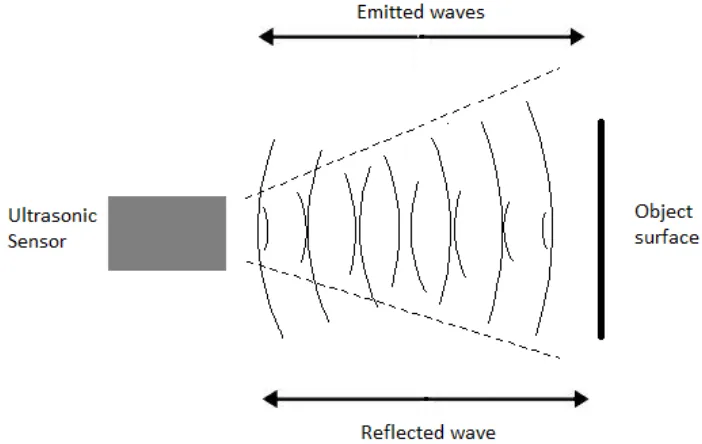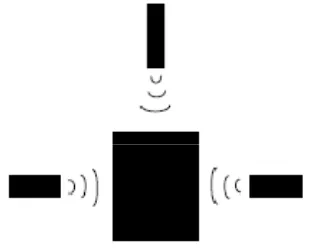Non-Intrusive Liquid Level Detection System
KHAIRUL ARIFFIN BIN MD SHARIFF
UNIVERSITI TEKNIKAL MALAYSIA MELAKA
This Report Is Submitted In Partial Fulfillment of Requirements For The Bachelor Degree of Electronic Engineering (Wireless Communication)
Fakulti Kejuruteraan Elektronik dan Kejuruteraan Komputer Universiti Teknikal Malaysia Melaka
“I hereby declare that this report is result of my own effort except for quotes as cited in the references.”
Signature : ……….
“I hereby declare that I have read this report and in my opinion this report is sufficient in terms of the scope and quality for the award of Bachelor of Electronic Engineering
(Wireless Communication) with honours”
Signature : ……….
Supervisor’s Name : Associate Professor Tan Kim See
i ACKNOWLEDGEMENT
Praised be to Allah for his blessings and giving me the strength along the challenging journey to completing the project as well as this thesis writing, for without it, I would not have been able to come this far.
First and foremost, I would like to express my sincere gratitude to my supervisor, Associate Professor Tan Kim See for the continuous support for my PSM, for his patience, motivation, enthusiasm, and immense knowledge. His guidance helped me in all the time of research, developing and writing of this thesis.
ii ABSTRACT
iii ABSTRAK
iv
2.1.1 Velocity of Ultrasound and Wavelength 6
2.2 Advantages of Ultrasonic 6
2.3 Principle of Level Measurement 7
2.3.1 Temperature 8
2.3.2 Humidity 8
2.4 Basic Application for Ultrasonic Transducer 8
2.4.1 Solid Level 8
v
CHAPTER TITLE PAGES
2.4.3 Height Difference 10
2.5 Literature Review 10
2.5.1 Operating Principle 10
2.5.2 Basic Calculation 11
2.6 Components 12
2.6.1 Ultrasonic Sensor 12
2.6.2 Microprocessor PIC 16F877A 14 2.6.3 Liquid Crystal Display 18
2.6.4 Regulator LM7805 19
3 PROJECT METHODOLOGY
3.1 Flowchart of project 20
3.2 Project Progress 24
4 RESULT AND DISCUSSION
4.1 Expected result 25
4.3.1 C Programming Language 32 4.3.2 Parallel Input/Output Port 33
4.3.3 Interrupt 34
4.3.4 Main Program 34
vi
CHAPTER TITLE PAGES
5 CONCLUSION AND SUGGESTION
5.1 Conclusion 40
5.2 Suggestion 41
REFERENCES 42
vii
Frequency ranges corresponding to ultrasound Operation of Ultrasonic Sensor
Application in measuring solid level Application in measuring object dimension Application of ultrasonic in height difference Illustration of operation
viii LIST OF TABLES
NO TITLE PAGE
2.6.4 3.2 4.3.4a 4.3.4b 4.3.4c
Pin out function for LCD Gantt chart
Relationship between Voltage and Distance Relationship between Voltage and Level
Comparison between actual value and reading from device
19 24 36 37 38
1 CHAPTER 1
INTRODUCTION
1.1 Background
Nowadays, level measurement is one of the most common types of measurement undertaken and is used significantly in many process systems. The most predominant area is the need to determine the amount of liquid in a vessel, such as a tank, in order to control and regulate the process. In the waste water industry for example, level measurement is used in maintaining the levels in chemical tanks. In this type of application, a level measurement device would monitor the level of chemical and the device would send out a signal when the tank is full or reaches a certain set level, shutting down the pump.
2 method that can be considered for this project is admittance, ultrasonic, magnetic, radar and differential pressure.
Most continuous monitoring systems use a transducer unit to interact with the liquid level being measured. Ultrasonic devices emit electromagnetic energy in order to detect the level of the liquid at that second. A non-contact device, such as Ultrasonic, does not require direct contact with the liquid surface in order to perform properly.
1.2 Problem Statement
The conventional method of measuring liquid level is by using a dipstick or calibrated float. However, this kind of method is not suitable in some situations for example, sometimes a sealed container cannot be opened, or its contents cannot be exposed. In industries, it is very common that the method used for measuring the liquid level is by using the direct contact method. The liquid, especially the corrosive chemical can corrode the sensor and can alter the quality of the liquid in a tank.
3 1.3 Objective
The main objective of this project is to develop an ultrasonic level measuring system for a liquid tank. It is a device that can measure the level of liquid inside the tank using ultrasonic wave and the liquid level can be displayed to the user either through a display panel or meter. This project looks into researches based on the ultrasound technology as non-intrusive sensor. In this project, the study of the transmitting and receiving concept of sound wave, the length of time, the equation of the wave velocity and calculation of the wave length are worked upon and determined. The software codes are also need to be developed for the PIC 16F877A (control the LCD display and calculation level of liquid).
1.4 Scope of Project
The scopes listed to ensure the project is conducted within its intended time frame and scale. It also helps to ensure that the project is heading in the right direction to achieve its objectives listed as follows:
1. study the principle and application of ultrasonic wave.
2. To construct and study the hardware of the circuit until it performs as desired.
4 Basically, this project is divided into two main parts:
1. Hardware design: The hardware for the ultrasonic level measuring system can
be broken down into three functional units, the LCD display, Ultrasonic circuit
and the PIC circuit. It consists of the operation of ultrasonic sensor to transmit and detect the sound wave and the operation to control the display and the
calculation for measurement.
2. Software design: The program for the ultrasonic level measuring system
essentially does two things: transmit a pulse and detect when the pulse is received. The program is developed to measure the time that elapsed between
the time transmission of the ping and reception of the pong. The display of the
measurement is made using LCD displays.
1.5 Project Methodology
5 CHAPTER 2
BACKGROUND THEORY
This chapter presents the background theory of ultrasonic wave including its characteristics that are useful in order to develop this project. The details of ultrasonic transducer are discussed and followed by explanation on the measurement principles. Several factors that can affect the performance of ultrasound are also included.
2.1 Ultrasonic
Ultrasound is the sound generated above the human hearing range (typically 20 kHz). Ultrasound is cyclic sound pressure with a frequency greater than the upper limit of human hearing. Ultrasound has a much shorter wavelength. It can be reflected off very small surfaces such as defects inside materials. It is this property that makes ultrasound useful for nondestructive testing of materials.
6
Figure 2.1 Frequency ranges corresponding to ultrasound
2.1.1 Velocity of Ultrasound and Wavelength
The velocity of ultrasound, c in a perfectly elastic material at a given temperature and pressure is constant. The relation between c, f, λ and T is given by Equation (1) and (2):
=
Equation (1)
=
Equation (2)Where λ = Wavelength
c = Material sound velocity f = frequency
T = Period of time
2.2 The Advantages of Ultrasonic
1. Able to measure and detect distances to moving objects 2. Impervious to target materials, surface and color
3. Solid-state units have virtually unlimited, maintenance-free lifespan 4. Detects small objects over long operating distances
5. Resistant to external disturbances such as vibration, infrared radiation and ambient noise
7
2.3 Principle of Level Measurement
The transducer (ultrasonic sensor) measures the length of time from the transmission to reception of the ultrasonic signal (pulse), reflected from an object that was transmitted from the sensor, thereby it calculates the distance and level between the sensor and the object its distance or level to be measured.
Figure 2.3 Operation of Ultrasonic Sensor
Distance [m] = {Pulse Delay Time x the Velocity of Sound} /2
The velocity of Sound in Air [m/sec] = 331.5 + 0.6 x Temperature [℃]
8 because some surfaces may produce scattered diffuse reflections, this will make the beam much weaker and not suitable for distance measuring purposes.
2.3.1 Temperature
The speed of sound varies with temperature: as air gets warmer, sound travels faster. Hence ultrasonic systems must incorporate a thermometer to estimate the current speed of sound. While the ambient air temperature can be measured, other warming effects, such as convection and turbulence, can cause errors in the calculated distance. Temperature also can affect the sound velocity in the atmosphere. The sound velocity in the atmosphere can reach 331.45 m/s when the temperature is 0°c.
2.3.2 Humidity
Humidity can influence attenuation of sound in air, which can affect the maximum range of an ultrasonic device. Attenuation is also related to the frequency of the emitted sound: higher frequencies improve the sampling resolution, but it reduces the maximum measurement distance.
2.4 Basic Applications of Ultrasonic Transducer
2.4.1 Solid Level
9
Figure 2.4.1 Application in measuring solid level
2.4.2 Object Dimension
Ultrasonic sensor also can measure dimension of an object. The height of an object can be measured from the floor until the top of the object. Width of an object can be determined by measuring the object from 2 sides. Figure 2.4.2 shows the application of ultrasonic in measuring object dimension.
10 2.4.3 Height Difference
Difference height of the object in the same line can be measure by ultrasonic. It is very useful to apply especially on a conveyor belt by discriminate out-of-dimension objects. Figure 2.4.3 shows the application in detecting the height difference.
Figure 2.4.3 Application of ultrasonic in height difference
2.5 Literature Review 2.5.1 Operating Principle
Ultrasonic Transmitter sends an electrical signal to the transducer piezoelectric crystal, which causes the crystal to vibrate and emit an ultrasonic pulse. The sound pulse is emitted toward the liquid surface. Then the signal reflected as an echo, back to the transducer. When the return signal echo is received, the electronic circuit converts the time interval into a distance. The relationship can be shown as below.
=


